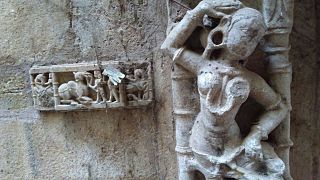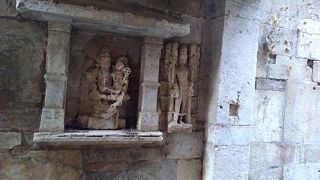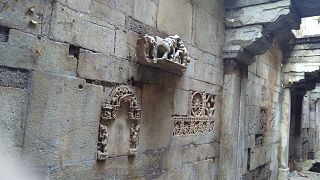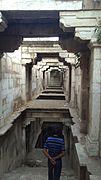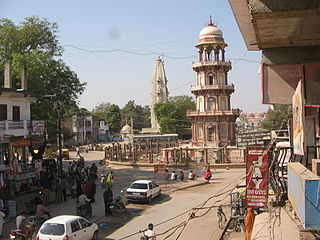
Banaskantha district is one of the thirty-three districts of the Gujarat state of India. The administrative headquarters of the district is at Palanpur which is also its largest city. The district is located in the Northeast of Gujarat and is presumably named after the West Banas River which runs through the valley between Mount Abu and Aravalli Range, flowing to the plains of Gujarat in this region and towards the Rann of Kutch. The district is famous for the Ambaji temple which draws many tourists. It covers an area of 12703 km2 and is the second largest district in the state.

Patan is the administrative seat of Patan district in the Indian state of Gujarat and is an administered municipality. It was the capital of Gujarat's Chavda and Chaulukya dynasties in medieval times, and is also known as Anhilpur-Patan to distinguish it from Prabhas Patan. During the rule of Gujarat Sultanate, it was the capital from 1407 to 1411.

Palanpur is a city and a municipality of Banaskantha district in the Indian state of Gujarat. Palanpur is the administrative headquarters of Banaskantha district. Palanpur is the ancestral home to an industry of Indian diamond merchants.

Stepwells are wells or ponds with a long corridor of steps that descend to the water level. Stepwells played a significant role in defining subterranean architecture in western India from 7th to 19th century. Some stepwells are multi-storeyed and can be accessed by a Persian wheel which is pulled by a bull to bring water to the first or second floor. They are most common in western India and are also found in the other more arid regions of the Indian subcontinent, extending into Pakistan. The construction of stepwells is mainly utilitarian, though they may include embellishments of architectural significance, and be temple tanks.

Khedbrahma is a town and a taluka headquarter in Khedbrahma Taluka of Sabarkantha district, Gujarat, India. It is situated on the banks of Harnav river. The town is connected with mythological history and has been pilgrim site for centuries. The 11th century Brahma, Ambika and Pankhnath Mahadev temples are the oldest monuments of the town. The town has an old stepwell, the Brahma Vav. It was under Parmaras, Chaulukyas and Pariharas before it came under Idar State in 13th century.

Tharad is a town in Tharad taluka in the Banaskantha district of the state of Gujarat in India. It is the administrative center of Tharad taluka. Tharad is near the border of Gujarat, 40 km from the border with Pakistan and 15 km from the Indian state of Rajasthan. Majority of its population follow the religion of Hinduism. Its main industries are agriculture and diamond polishing. It is one of the first major towns in Gujarat on National Highway 15.

Sathamba is a town located in Aravali district of the Indian state of Gujarat and the seat of a former petty princely state. It has a population of approximately 15,000.

Rani Ki Vav is a stepwell situated in the town of Patan in Gujarat, India. It is located on the banks of the Saraswati River. Its construction is attributed to Udayamati, the spouse of the 11th-century Chaulukya king Bhima I. Silted over, it was rediscovered in the 1940s and restored in the 1980s by the Archaeological Survey of India. It has been listed as one of the UNESCO World Heritage Sites in India since 2014.

Vav is a town and the headquarters of Vav Taluka in Patan district in Gujarat state of India. Vav is the largest taluka of the district.
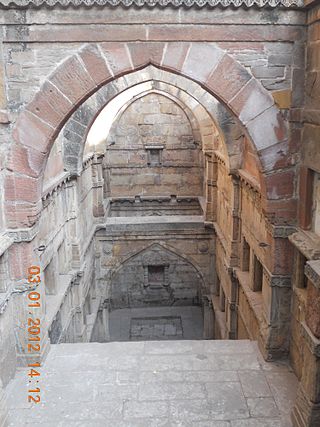
Amritavarshini Vav, also known as Panchkuva Stepwell or Katkhuni Vav, is a stepwell near the Panchkuva Darwaja in Ahmedabad, Gujarat, India.
Vav is one of the 182 Legislative Assembly constituencies of Gujarat state in India. It is part of Banaskantha district. It is numbered as 7-Vav.

Kumbhariya is a village of historical, archaeological and religious importance with cultural heritage in Danta Taluka of Banaskantha district, Gujarat, India.
The history of Palanpur starts with its relation to the historic city of Chandravati ruled by Paramara dynasty. The town was re-peopled and ruled by Chauhans around thirteenth century. At the start of the seventeenth century, the Palanpur State was taken over by Jhalori dynasty of Pashtun Lohani (Bihari-Pathan) tribe which was founded in 1373 and ruled from Jhalor. The dynasty came into historical prominence during the period of instability that followed the demise of Mughal Emperor Aurangzeb in the early 18th century. It was overrun soon afterwards by the Marathas; the Lohanis followed the trend of seeking recourse in the British East India Company against them and finally entered the subsidiary alliance system in 1817, along with all other neighbouring states, becoming a British protectorate governed by Palanpur Agency. After independence of India in 1947, Palanpur State was dissolved in 1949 and merged with India as a part of Bombay State. Subsequently, Palanpur became the capital of Banaskantha district of Gujarat.(Hebatpur)
Suigam was a village in Vav Taluka of Maratha Riyasat in Gujarat, India, but it is now a Taluka of Banaskantha district in Gujarat.
Morvada is a village in Vav Taluka of Banaskantha district in Gujarat, India.
Dhima is a village in Vav Taluka of Banaskantha district in Gujarat, India.
Stepwells are wells in which the water is reached by steps. They are most commonly found in western India especially Gujarat where over 120 such wells are reported. The origin of the stepwell may be traced to reservoirs of the cities of the Indus Valley civilization such as Dholavira and Mohenjo-daro. The stepwells were constructed in the south western region of Gujarat around 600 AD. From there they spread north to Rajasthan and subsequently to north and west India. Construction activities accelerated during the tenth to 13th century during the Chaulukya and Vaghela periods. The construction of these stepwells hit its peak during the 11th to 16th century. The Muslim rulers of the 13th to 16th century did not disrupt the culture that was practiced in these stepwells and encouraged the building of stepwells. The wells lost their significance in the 19th century due to introduction of water pumps and pipe-systems.
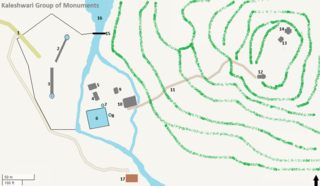
The Kaleshwari Group of Monuments, also known as Kaleshwari-Ni Nal, is located near Lavana village, Khanpur Taluka of Mahisagar district, Gujarat, India. It is near the district headquarters Lunavada and near a stream in Hidimba Van, the forest of Hidimba. The group includes intricately-carved temple ruins, two stepwells, a reservoir, structures with panels of erotic sculptures and idols scattered all over the site. The ruins are located at the foothills and on the hillock. They were built between the 10th and 16th century; some monuments were reconstructed after the 18th century. These are State Protected Monuments.
Madhavav or Madhav Vav is a stepwell located in Wadhwan town of Surendranagar district, Gujarat, India. It is located in the western side of old town.

The Khed-Roda Group of Monuments include eighth-ninth century dated seven Hindu temples built during Gurjara-Pratihara or Rashtrakuta period. It also include a reservoir (Kund) and a stepwell. They are located between Raisingpura (Roda) and Khed Chandarani villages, 18 km from Himmatnagar in Sabarkantha district of Gujarat, India. It is located on the bank of the seasonal stream which merges Hathmati river downstream.

